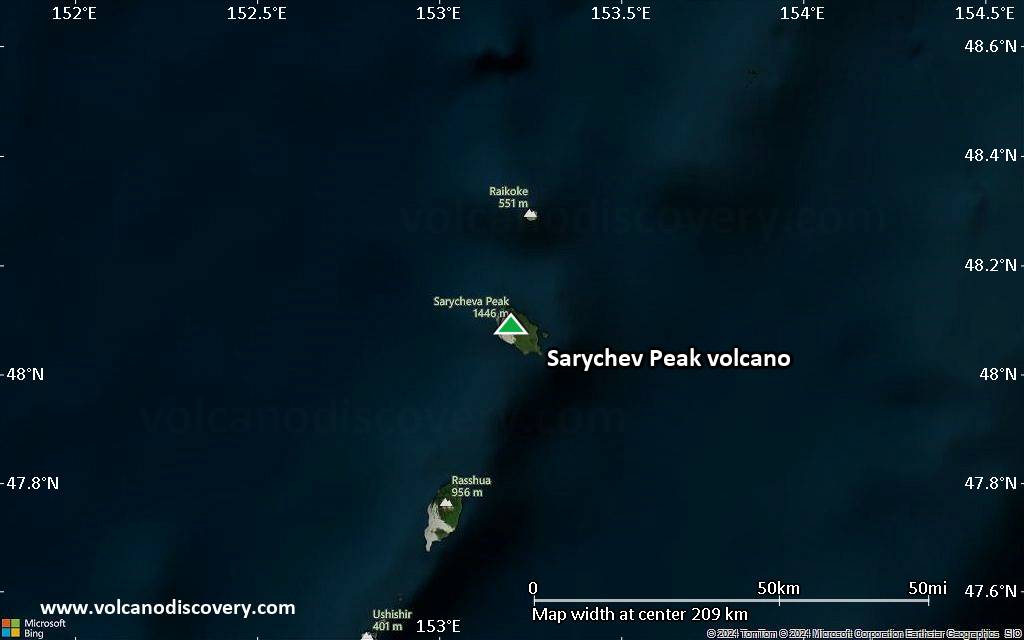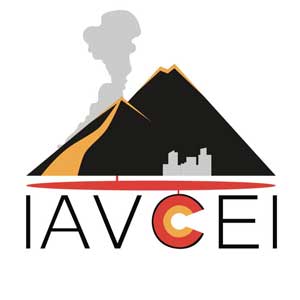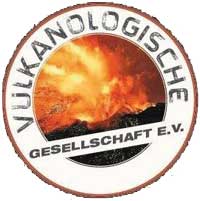Sarychev volcano (Kurile Islands, Russia): thermal hot spot and gas plume
Wednesday, Oct 27, 2021 | 4 years ago · T

Sarychev Peak volcano (Matua Island, Russia) - Smithsonian / USGS Weekly Volcanic Activity Report for 11 August-17 August 2021 (New Activity / Unrest)
Wednesday, Aug 11, 2021 | 4 years ago · VN
SVERT reported that an emission of sulfur dioxide from Sarychev Peak was identified in satellite data on 15 August.
Source: Sakhalin Volcanic Eruption Response Team (SVERT)
---
From: Global Volcanism Pro…Open article
Source: Sakhalin Volcanic Eruption Response Team (SVERT)
---
From: Global Volcanism Pro…Open article
Show more
Sarychev Peak volcano (Matua Island, Russia) - Smithsonian / USGS Weekly Volcanic Activity Report for 7 July-13 July 2021 (New Activity / Unrest)
Wednesday, Jul 7, 2021 | 4 years ago · VN
SVERT reported that on 29 June and 1 July brief ash emissions from Sarychev Peak rose to 3 km (10,000 ft) a.s.l. A weak thermal anomaly identified in satellite data persisted through 12 July; SVERT lo…Open article
Sarychev Peak Volcano Volcanic Ash Advisory: VA IS NOT IDENTIFIABLE IN SATELLITE IMAGERY.
Thursday, Jul 1, 2021 | 4 years ago · VN
Das Warnzentrum für Vulkanasche VAAC Tokyo brachte folgende Meldung heraus: VA IS NOT IDENTIFIABLE IN SATELLITE IMAGERY.
Originaltext:
FVFE01 at 11:50 UTC, 01/07/21 from RJTD
VA ADVISORY
DTG: 20210701/115…Open article
Originaltext:
FVFE01 at 11:50 UTC, 01/07/21 from RJTD
VA ADVISORY
DTG: 20210701/115…Open article
Sarychev Peak volcano (Kuril Islands): Volcanic Alert Level raised to Yellow
Thursday, Jul 1, 2021 | 4 years ago · martin

SVERT reported that ash emissions were identified in a satellite image today.
An ash plume reached 10,000 ft (3,048 m) altitude and extended about 30 km to the W-NW of the volcano.
Satellite images fr…Open article
An ash plume reached 10,000 ft (3,048 m) altitude and extended about 30 km to the W-NW of the volcano.
Satellite images fr…Open article
Sarychev Peak volcano (Matua Island, Russia) - Smithsonian / USGS Weekly Volcanic Activity Report for 30 June-6 July 2021 (New Activity / Unrest)
Wednesday, Jun 30, 2021 | 4 years ago · VN
The Tokyo VAAC and SVERT reported that during 30 June-1 July ash plumes from Sarychev Peak rose to 3-5.5 km (10,000-18,000 ft) a.s.l. and drifted W, SE, and E based on satellite images. Plumes drifted…Open article
Sarychev Peak Volcano Volcanic Ash Advisory: VA IS NOT IDENTIFIABLE IN SATELLITE IMAGERY.
Tuesday, Jun 29, 2021 | 4 years ago · VN

Das Warnzentrum für Vulkanasche VAAC Tokyo brachte folgende Meldung heraus: VA IS NOT IDENTIFIABLE IN SATELLITE IMAGERY.
Originaltext:
FVFE01 at 17:50 UTC, 29/06/21 from RJTD
VA ADVISORY
DTG: 20210629/175…Open article
Originaltext:
FVFE01 at 17:50 UTC, 29/06/21 from RJTD
VA ADVISORY
DTG: 20210629/175…Open article
Sarychev Peak volcano (Matua Island, Russia) - Smithsonian / USGS Weekly Volcanic Activity Report for 23 June-29 June 2021 (New Activity / Unrest)
Wednesday, Jun 23, 2021 | 4 years ago · VN
SVERT reported that thermal anomalies over Sarychev Peak were identified in satellite images on 12, 23, 25, and 29 June. At 0020 on 30 June an ash plume was visible in satellite data rising 3 km (10,0…Open article
Sarychev Peak volcano (Matua Island, Russia) - Smithsonian / USGS Weekly Volcanic Activity Report for 17 February-23 February 2021 (New Activity / Unrest)
Wednesday, Feb 17, 2021 | 4 years ago · VN
SVERT noted that thermal anomalies over Sarychev Peak were identified in satellite images during 9-10 and 12-14 February. KVERT reported on 19 February that the effusive eruption was over, though lava…Open article
Sarychev Peak volcano (Matua Island, Russia) - Smithsonian / USGS Weekly Volcanic Activity Report for 10 February-16 February 2021 (New Activity / Unrest)
Wednesday, Feb 10, 2021 | 4 years ago · VN
KVERT reported that a thermal anomaly over Sarychev Peak was identified in satellite images during 5-12 February. The Aviation Color Code remained at Yellow (the second lowest level on a four-color sc…Open article
Show more
Sarychev Peak volcano (Matua Island, Russia) - Smithsonian / USGS Weekly Volcanic Activity Report for 3 February-9 February 2021 (New Activity / Unrest)
Wednesday, Feb 3, 2021 | 4 years ago · VN
KVERT reported that the eruption at Sarychev Peak continued during 29 January-5 February, characterized by lava effusion from the crater onto the N flank. A thermal anomaly was identified in satellite…Open article
Sarychev Peak volcano (Matua Island, Russia) - Smithsonian / USGS Weekly Volcanic Activity Report for 27 January-2 February 2021 (New Activity / Unrest)
Wednesday, Jan 27, 2021 | 4 years ago · VN
KVERT reported that the eruption at Sarychev Peak continued during 22-29 January, characterized by lava effusion from the crater onto the N flank. A daily thermal anomaly was identified in satellite i…Open article
Sarychev Peak volcano (Kuril Islands): new lava flow
Thursday, Jan 21, 2021 | 4 years ago · martin

Increasing trend of the volcano continues over the past ten days as elevated surface temperature was detected on 10 January likely caused by new batch of magma rising inside the volcano's conduits tow…Open article
Sarychev Peak volcano (Matua Island, Russia) - Smithsonian / USGS Weekly Volcanic Activity Report for 20 January-26 January 2021 (New Activity / Unrest)
Wednesday, Jan 20, 2021 | 4 years ago · VN
KVERT reported that lava began to effuse from a vent in Sarychev Peak’s summit crater 10 January, and by 20 January it had traveled about 400 m down the N flank. A gas-and-steam plume drifted 36 km NE…Open article
Sarychev Peak volcano (Matua Island, Russia) - Smithsonian / USGS Weekly Volcanic Activity Report for 13 January-19 January 2021 (New Activity / Unrest)
Wednesday, Jan 13, 2021 | 4 years ago · VN
KVERT reported that a thermal anomaly over Sarychev Peak was identified during 7-10 and 12-13 January. A gas-and-steam plume drifted 40 km NE on 12 January. The Aviation Color Code was raised to Yello…Open article
Sarychev Peak volcano (Kuril Islands): increasing activity
Monday, Jan 11, 2021 | 4 years ago · martin

Activity of the volcano continues at elevated levels.
KVERT reported that on 10 January at 15:17 UTC KVERT a difference between thermal anomaly and background temperature was 79,8 °C identified in VolS…Open article
KVERT reported that on 10 January at 15:17 UTC KVERT a difference between thermal anomaly and background temperature was 79,8 °C identified in VolS…Open article
Sarychev Peak volcano (Matua Island, Russia) - Smithsonian / USGS Weekly Volcanic Activity Report for 6 January-12 January 2021 (New Activity / Unrest)
Wednesday, Jan 6, 2021 | 4 years ago · VN
KVERT raised the Aviation Color Code to Yellow (the second lowest level on a four-color scale) for Sarychev Peak on 10 January, noting that the temperature of a thermal anomaly was 79.8 degrees Celsiu…Open article














